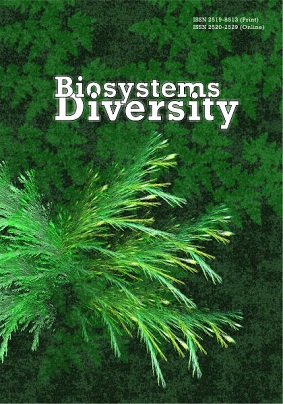Еколого-географічна характеристика водоростевих угруповань черепашок черевоногих молюсків р. Уж
Ecological and geographical characteristics of algal communities on gastropod shells of the river Uzh
Author(s): G. Y. Kyrychuk, M. O. Metelska, N. M. KorniichukSubject(s): Environmental Geography, Human Ecology, Environmental interactions
Published by: Дніпропетровський національний університет імені Олеся Гончара
Keywords: algal epibionts; saprobity; indicator species; ecological group; morphological group;
Summary/Abstract: Freshwater molluscs serve as test objects in the ecological monitoring of the environment, because they are able to extract in indicator quantity from the environment and accumulate in their bodies radionuclide's, various macro and micronutrients, toxic substances of inorganic and organic origin, and so on. The gastropods are a taxonomically diverse, ecologically plastic and rather widespread group of aquatic organisms, whose role in the life of freshwater ecosystems is very important. Molluscs often have various interactions in biogeocenoses that determines their trophic net. As a rule, these interactions occur in the form of ectocommensalism, endocommensalism, supercrescence, predation or parasitism. The latter type of interaction is the subject of many studies, but the epibionts of gastropods and bivalves are practically not studied and that causes the relevance of the research. Species composition of algal epibionts identifies specific sensitivity to the effects of certain environmental factors and reflects the processes occurring in water bodies of its ecosystem. This determines their efficient use for analyzing changes of water bodies, particularly in terms of complex anthropogenic pressure on aquatic ecosystems, as aquatic habitat. The aim of the research was to determine the ecological characteristics of algal communities on gastropod shells: Lymnaea stagnalis, L. auricularia and Viviparus viviparus (the Uzh river, Korosten district, Zhytomyr region). Identified microalgae communities were grouped and studied according to such indices as: confinedness to the habitat (substrate), temperature, fluidity and water oxygenating, saprobiological characteristics according to the Pantle-Buck system in the modification of Sladecek and Watanabe, salinity according to Kolbe’s system, pH at Hustedt scale in the interpretation of M. M. Davydova and geographical confinedness of objects of study. Algae fouling on shells L. stagnalis, L. auricularia and V. viviparous are formed by benthic and benthic-planktonic species. Algal epibionts of studied communities are mainly confined to slowflowing waters. The basis of a floristic list according to the temperature in all studied groups of gastropods formed indifferent species. According to geographical distribution of algae fouling cosmopolitan species dominated. In relation to salinity according to Kolbe’s system, most discovered species were indifferent oligo-galob. Algal communities are reliable indicators of one of the important indices of watercourse hydrochemical conditions – pH of water. Analysis of algal epibionts on gastropod shells of the river Uzh, showed the dominance of alkaliphiles and indifferent species (from the number of identified microalgae). According to saprobiological characteristic of water quality of the river Uzh predominance of o-saprobes. Analysis of indicator groups showed that the most numerous algal epibionts on shells were euresaprobe species. A detailed ecological and geographical characteristic of algae fouling on shells of studied groups of molluscs allows to predict the state of hydrocenose, that is an important aspect of monitoring and requires further research to model the influence of anthropogenic factors on the state of waters.
Journal: Biosystems Diversity
- Issue Year: 25/2017
- Issue No: 3
- Page Range: 186-190
- Page Count: 5
- Language: Ukrainian

